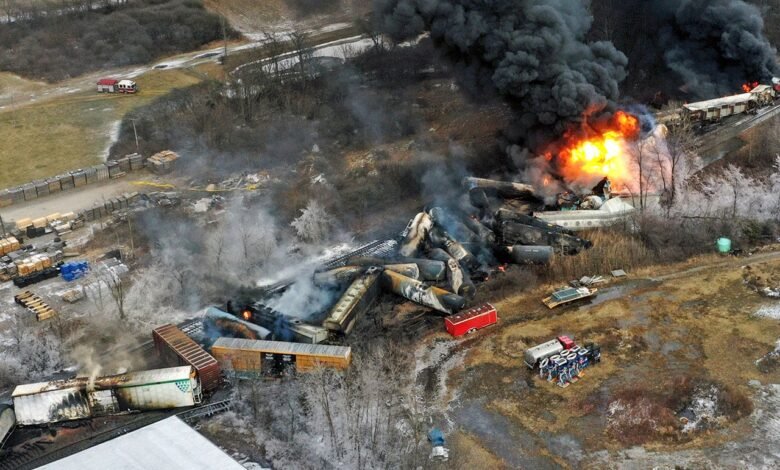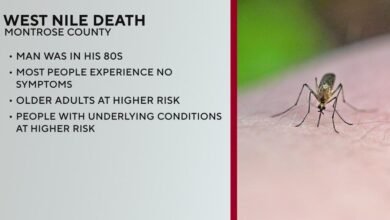Trump Pledges Shocking $10M for Health Crisis Post-Toxic Spill in East Palestine!

Trump Administration Initiates $10 Million Health Study for East Palestine Residents Post-Toxic Spill
In a proactive response to the alarming situation that arose after the toxic train derailment in East Palestine, Ohio, the Trump administration has rolled out a substantial $10 million health study aimed at assessing the long-term effects of chemical exposure on the local residents. This decisive action comes as a glimmer of hope for a community shaken by environmental disasters, signaling the government’s commitment to safeguarding public health.
The Context of the Disaster
Earlier this year, the community of East Palestine experienced an industrial disaster when a freight train carrying hazardous materials derailed, leading to the release of toxic substances into the environment. The incident raised immediate concerns about air and water quality, as well as potential long-term health implications for the residents exposed to the spill. The situation captured national attention, highlighting the ongoing issues surrounding environmental safety and community health in the wake of such disasters.
The Health Study: Objectives and Scope
The newly initiated health study aims to canvas the health impacts on both residents living in the vicinity of the derailment and emergency responders who dealt with the aftermath. The study intends to:
- Identify Health Risks: Uncover and document any health issues arising from exposure to the toxic substances.
- Monitor Health Outcomes: Track the short- and long-term health outcomes of those affected by the spill.
- Inform Future Protocols: Provide crucial data that could inform future responses to environmental disasters.
By focusing on these key areas, the health study seeks to establish comprehensive health profiles for residents and to enhance the understanding of the repercussions of such environmental catastrophes.
Implications for the Community
The impact of the train derailment and subsequent chemical leak has been profound for the residents of East Palestine. Many individuals expressed anxiety over potential health hazards. Reports of respiratory issues, skin irritations, and other health concerns have surged since the incident. The forthcoming study is pivotal in addressing these fears and fostering a sense of assurance among the community.
Furthermore, community members are eager for transparency regarding the environmental conditions of their locality. There remains widespread concern about contaminated air, soil, and water sources. This health study represents a critical step toward providing scientific evidence that residents can rely on and a pledge from the government that their health is a priority.
Government Response and Community Engagement
The Trump administration’s swift initiative underscores a broader strategy to not only respond to disasters but to engage affected communities in meaningful dialogue. Alongside funding for health studies, the government anticipates rolling out various outreach programs aimed at educating residents about potential health risks and preventive measures. Local town hall meetings are likely to be a part of this effort, as officials seek to foster a collaborative approach to rebuilding community trust.
Government agencies, including the Environmental Protection Agency (EPA), are collaborating with health professionals to ensure that the study is comprehensive and considers various factors affecting public health. Importantly, public participation in the study can enhance its accuracy and effectiveness, encouraging residents to voice their health concerns and share relevant health data.
Challenges and Criticisms
While the $10 million health study is a welcome initiative, it is not without its challenges and criticisms. Some community members wonder if the funding will be sufficient to conduct an exhaustive assessment, given the complexity of chemical exposure and the potentially widespread health effects. Others express skepticism about government transparency and accountability, fearing that their concerns may be downplayed or ignored.
Additionally, the effectiveness of the study hinges on community engagement. If residents are hesitant to participate due to distrust or fear of negative repercussions, the study’s findings may not reflect the true impact of the spill on public health. As such, building a solid rapport with the East Palestine community is paramount for the initiative’s success.
Looking Ahead: What This Means for Public Health Policy
This health study could serve as a pivotal moment for evolving public health policy, establishing benchmarks for future responses to similar environmental incidents. As research findings emerge, they could influence the government’s approach to disaster management, safety regulations, and remediation processes.
Moreover, the transparency and pursuit of accurate health information exemplified through this study could establish a model for other communities facing similar challenges. The lessons learned here may well guide how federal agencies interact with local populations in the aftermath of disasters.
Conclusion: A Step Toward Recovery
The Trump administration’s $10 million health study for East Palestine residents is an essential first step in addressing the health concerns stemming from the toxic train derailment. By focusing on community needs, engaging with residents, and providing a transparent and thorough examination of health risks, this initiative has the potential to rebuild trust and pave the way for better public health strategies in the future.
As East Palestine contends with the aftermath of the environmental disaster, the commitment to understanding and addressing health outcomes is paramount. This health study represents not only a financial investment but also a moral obligation to uphold the well-being of affected individuals and prioritize their health moving forward.
Summary of Key Points
- The Trump administration has launched a $10 million health study for residents of East Palestine following a toxic train derailment.
- The study aims to assess health risks and monitor outcomes for both residents and emergency responders.
- Community engagement and transparency are critical for the success and accuracy of the study.
- Concerns about funding sufficiency and potential distrust among residents pose challenges to the initiative.
- The health study could shape future public health policies and responses to environmental disasters.





